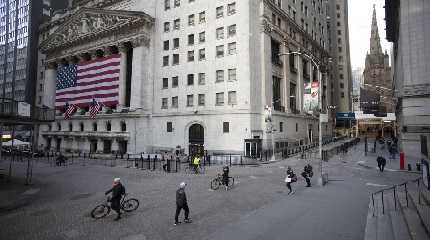
NEW YORK (AP) — Stocks are back to tumbling on Wall Street Thursday as rising bond yields and worries about a possible recession put the squeeze back on markets.
The S&P 500 was 2.1% lower in midday trading and back to its lowest level since late 2020. The washout has the index on track to more than erase its big rally from a day before. That’s when forceful moves by the Bank of England to get suddenly spiking U.K. yields under control triggered a global burst of relief among investors.
That renewed calm seems to have lasted just a day, though. For markets to really turn higher, after the U.S. stock market has lost more than 20% of its value this year, analysts say investors will need to see a break from the high inflation that’s sweeping the world.
That hasn’t arrived yet, with even more data arriving Thursday showing the opposite. And that means the Federal Reserve and other central banks will keep pushing interest rates higher to slow their economies in hopes of pushing down inflation. By doing that, they’re also risking recessions if they go too far.
The Dow Jones Industrial Average was down 504 points, or 1.7%, at 29,178, as of 11:05 a.m. Eastern time, and the Nasdaq composite was 3% lower.
Stocks fell as the yield on the 10-year Treasury rose to 3.77% from 3.73% late Wednesday. The yield on the two-year Treasury, which more closely tracks expectations for Fed moves, rose more aggressively to 4.22% from 4.14%.
A stronger-than-expected report on the U.S. jobs market bolstered expectations for the Fed to keep raising rates and hold them at high levels for a while, potentially through 2023.
Fewer workers filed for unemployment benefits last week than economists expected. That’s good news for workers in general and an indication layoffs aren’t widespread despite worries about the economy. But it also keeps upward pressure on inflation, which gives the Fed more ammunition to raise rates.
It’s already zoomed its benchmark overnight interest rate to a range of 3% to 3.25%, up from basically zero as recently as March. That’s its highest level in more than 14 years, and the wide expectations is for it to rise by at least another full percentage point by early 2023.
Higher interest rates not only slow the economy and invite the possibility of a recession, they also push down on prices for stocks and all kinds of other investments. Investments seen as the most expensive or the riskiest tend to take the hardest hits.
Economic reports elsewhere around the world also firmed expectations for higher rates coming in the future. In Germany, for example, a reading on inflation came in hotter than expected.
In the U.K., meanwhile, Prime Minister Liz Truss defended her plan to cut taxes even though critics said it would worsen inflation. The plan had sent U.K. bond yields spiking, forcing the Bank of England on Wednesday to pledge to buy however many U.K. government bonds are needed to lower yields. The bond-buying announcement came just before the central bank had planned to do the exact opposite and sell some of the bonds it had purchased earlier to support the economy.
Even beyond the worries about central banks and rates, many other concerns continue to hang over markets.
A supercharged U.S. dollar has climbed so much so quickly against other currencies that investors worry something could break somewhere in global markets. Europe’s already struggling economy looks to be facing more pressure from high energy prices amid accusations that someone deliberately damaged pipelines delivering gas from Russia to Germany. And in the U.S., investors are concerned that one of the main levers setting stock prices may be under threat as corporate profits bend under higher interest rates, a slowing economy and high inflation.




